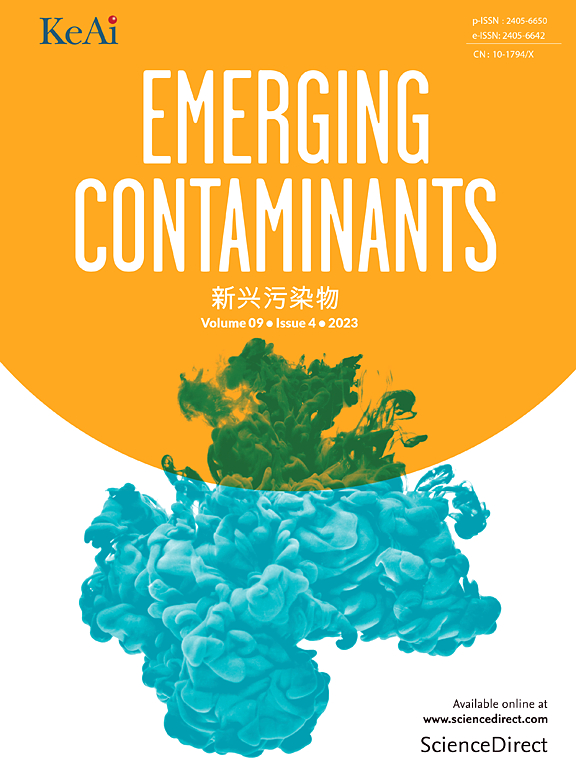Seasonal differences, source, and fate of antibiotics in a plain river network-informed watershed
IF 6.9
2区 环境科学与生态学
Q1 ENVIRONMENTAL SCIENCES
引用次数: 0
Abstract
The source apportionment and ecological risk assessment of antibiotics in plain river network areas have become a research hotspot. In this study, the Changxing Plain River Network in the Taihu Lake Basin was chosen as the research area, where the Positive Matrix Factorization (PMF) model was used for source apportionment and the Risk Quotient (RQ) and Hazard Index (HI) method were applied for ecological risk assessment. Seasonal variations revealed that antibiotic concentrations were higher during the dry season (N.D-138 ng/L) compared to the wet season (N.D ∼ 22 ng/L), with concentrations in the Jiapu River significantly exceeding those in the other three rivers. PMF model identified four major pollution sources: aquaculture (11 %), diffuse pollution (42 %), urban sewage (30 %), and agriculture (17 %), with diffuse pollution being the largest contributor to antibiotic pollution. Antibiotic flux calculations indicated that the Jiapu River contributed the highest antibiotic load to Taihu Lake, followed by the Changxing River. Ecological risk analysis based on RQ values revealed that erythromycin (ERY), sulfamethoxazole (SMX), and enrofloxacin (ENO) posed moderate risks during the dry season. This study underscores the impacts of various human activities on riverine antibiotic emissions; highlights the need for effective regulation of urban and diffuse pollution; and provides a scientific basis for the formulation of pollution prevention strategies for antibiotic management in Taihu Lake.

平原河网信息流域抗生素的季节差异、来源和命运
平原河网地区抗生素来源分配及生态风险评价已成为研究热点。本研究以太湖流域长兴平原河网为研究区,采用正矩阵分解(PMF)模型进行污染源划分,采用风险商(RQ)法和危害指数(HI)法进行生态风险评价。季节变化表明,旱季抗生素浓度(n d -138 ng/L)高于雨季(n d - 22 ng/L),其中嘉浦江的浓度显著高于其他3条河流。PMF模型确定了四个主要污染源:水产养殖(11%)、弥漫性污染(42%)、城市污水(30%)和农业(17%),其中弥漫性污染是抗生素污染的最大来源。抗生素通量计算结果表明,嘉浦江对太湖的抗生素负荷最大,其次是长兴江。基于RQ值的生态风险分析显示,红霉素(ERY)、磺胺甲恶唑(SMX)和恩诺沙星(ENO)在旱季具有中等风险。这项研究强调了各种人类活动对河流抗生素排放的影响;强调需要有效管制城市和扩散污染;为制定太湖抗生素污染防治策略提供科学依据。
本文章由计算机程序翻译,如有差异,请以英文原文为准。
求助全文
约1分钟内获得全文
求助全文
来源期刊

Emerging Contaminants
Medicine-Public Health, Environmental and Occupational Health
CiteScore
10.00
自引率
6.70%
发文量
35
审稿时长
44 days
期刊介绍:
Emerging Contaminants is an outlet for world-leading research addressing problems associated with environmental contamination caused by emerging contaminants and their solutions. Emerging contaminants are defined as chemicals that are not currently (or have been only recently) regulated and about which there exist concerns regarding their impact on human or ecological health. Examples of emerging contaminants include disinfection by-products, pharmaceutical and personal care products, persistent organic chemicals, and mercury etc. as well as their degradation products. We encourage papers addressing science that facilitates greater understanding of the nature, extent, and impacts of the presence of emerging contaminants in the environment; technology that exploits original principles to reduce and control their environmental presence; as well as the development, implementation and efficacy of national and international policies to protect human health and the environment from emerging contaminants.
 求助内容:
求助内容: 应助结果提醒方式:
应助结果提醒方式:


